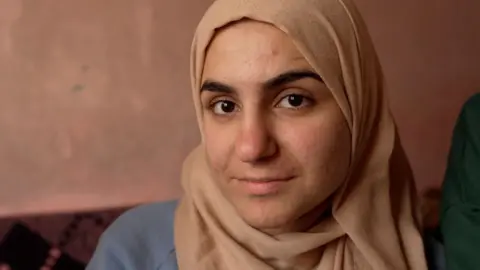 Francesco Tosto/BBC
Francesco Tosto/BBC“Even now, I still look back and wonder how we survived this nightmare,” Baraa says quietly.
The university student, now 20 years old, joined the joyful celebrations that filled the streets of Syria last Sunday for the end of Bashar al-Assad’s rule.
Her sisters, Alaa and Jana, nod in agreement as we sit huddled together on this cold winter day, on an old, lumpy sofa in their modest home in Homs.
Their white-bearded father, Farhan Abdul Ghani, sitting on the ground, answers: “We didn’t want war. We didn’t want a president forever building monuments to himself.”
Nearly a decade ago, we met for the first time in the worst days of that war, waged in the name of their president.
Baraa, a severely traumatized little girl whose eyes were darting back and forth violently, struggled to speak.
“Sometimes people would kill cats to eat,” she exclaimed As she sat in an abandoned banquet hall with aid officials, Syrian security forces and stricken families.
For months, many had little to eat except grass dug up from the ground, tree leaves, and sometimes boiled in water with salt and cinnamon.
“Instead of learning to read and write, I learned weapons,” Baraa told us then, matter-of-factly.
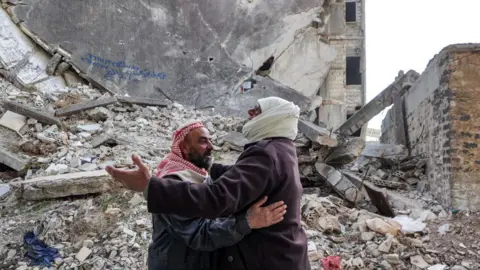 Getty Images
Getty ImagesHoms was once called the “capital of the revolution” by peaceful protesters who first took to the streets in the spring of 2011 to demand change, before it descended into all-out war.
Baraa and her family were among thousands of civilians rescued from the Old City during a rare humanitarian truce under UN supervision in February 2014.
They somehow survived the agonizing two-year siege of the Old Quarter as Syrian forces imposed the first “surrender or starve” cordon of this cruel war.
The medieval tactic of torture has turned into one of their cruelest weapons, unleashed on rebel-held strongholds one by one.
Months later, more civilians were also given safe passage out of the Old City, as well as fighters who moved on to continue their fight in other parts of Syria.
The years up until this week have been difficult for this family and many others.
“I felt like I was asleep and lost hope,” Baraa recalls as she adjusts the white veil that she and her sisters wear. “We were always afraid of saying the wrong thing, even at university.”
Now, like many Syrians, she is filled with palpable joy and optimism in these first lively days of a new beginning.
“I dream of many things now: to finish my studies, get a master’s degree, and improve my English.” Her voice fades as her big goals fill this modest little room.
A frightened little girl whose name means “innocence” has matured into a confident young woman wearing trendy blue jeans and a light blue fleece.
Her doting father, whose name means happiness, radiates pride. He was able to raise his daughters alone after their mother was killed by a missile that hit their kitchen. It was the children who found her there, slumped over the stove.
His meager income from the fruit and vegetable cart, as well as the kindness of friends, kept them striving for a better life.
“Everything is cheaper now, including food and electricity,” he says enthusiastically, referring to lower prices in markets because roads are now open and soldiers at checkpoints no longer stop goods or demand bribes.
It is a blessing for a country where the United Nations says 90% of Syrians live below the poverty line. “Today I can buy meat,” he gushed.
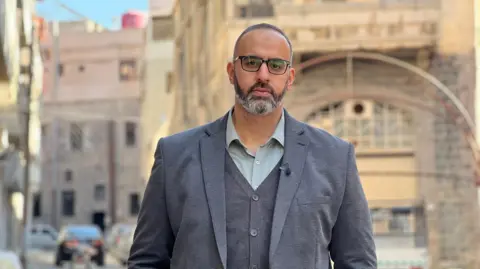 Francesco Tosto/BBC
Francesco Tosto/BBCOld wounds are still open and painful. Like tens of thousands of other Syrians, he lost a dear brother in the secret torture cells of Sednaya prison. When the doors of this notorious prison in Damascus opened last week, he did not emerge.
This excruciating pain and joyful happiness is becoming clear, especially for the Syrians who are now able to return to Homs. Entire sections remain jagged cityscapes of gray ruins and colossal ruins.
“I needed to see this again, but it brings up painful memories of the past,” says Dr. Hayan Al-Abrash, his eyes taking in the painful scene of loss in the Khalidiya neighborhood, which was destroyed by Syrian firepower.
He points to the skeletal remains of a high-rise building whose facade was destroyed by a Scud missile. It led to two other buildings collapsing to the ground.
He was also forced to leave the besieged Old City in 2014, leaving behind a makeshift underground hospital there and in nearby Khalidiya.
He struggles to locate it until a shopkeeper appears and opens a metal shutter. It reveals a ruined warehouse with rickety metal stairs leading down to a damp, dark basement.
“Yes, yes, this is it,” I announce excitedly as our flashlights illuminate the cavernous space, including another set of stairs. “This is where patients come in,” he explains.
“Sometimes I would bring friends, neighbors and my cousin down these stairs on my back.”
It’s next to a wall dotted with arrows that point to “Emergency Room” as well as “Road to Death” — a darker sense of humor than this room.
It features the green and black opposition flag, which is now everywhere.
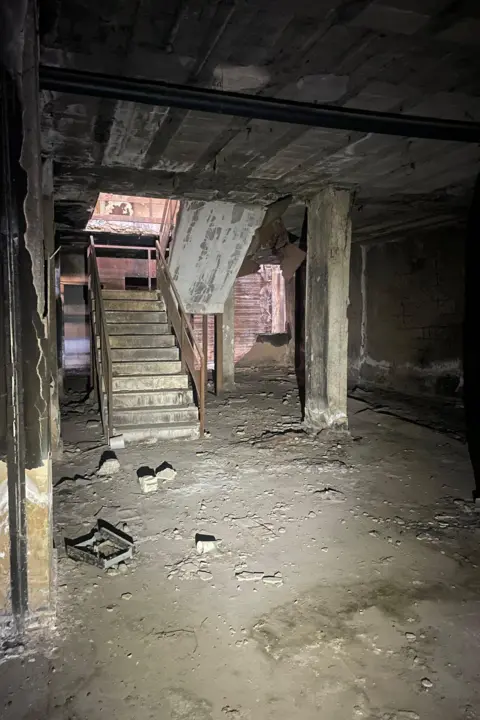
Empty medicine bottles and dirty cardboard bags are scattered in a far corner of the room where the wall is charred.
“The regime lit that fire in retaliation,” he says with increasing emotion. “They feared doctors, lawyers and political figures more than they feared fighters.”
“Seeing this makes me very angry,” he asserts.
I ask if this makes him want revenge.
“This is not the time for revenge,” he says. “It is time to build a Syria for everyone, but not for those who killed us and have blood on their hands and must be put on trial.
“We do not forgive. This is impossible for us.”
Everyone we spoke to in Homs said its residents, Muslims and Christians, would rebuild together, and the stories we heard seemed to confirm that.
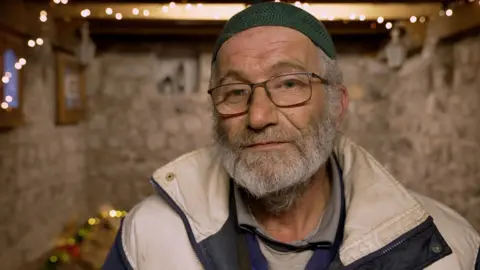 Francesco Tosto/BBC
Francesco Tosto/BBCDr. Hayyan also takes us to see the site of another underground hospital in the Old City – it was located in a spacious church basement where the walls are now lined with chairs and stacked tables for family gatherings.
Farhan and his daughters insisted on taking us to see where they had taken shelter for most of their time during the siege – a shelter in the Jesuit monastery then run by the charismatic Father Frans der Logt.
The Dutch priest, who was killed in the Old City when he refused to leave its besieged and starving residents, is now buried in the ground.
The current priest, Father Tony Al-Homsi, was surprised when we suddenly appeared with Farhan, surrounded by his daughters, frantically scrolling through his phone to find pictures from that time.
The Syrian Jesuit priest leads us down the stairs into the narrow room now used for daily Mass, which has recently been transformed into a Christmas grotto with a resplendent nativity scene.
“It’s a very beautiful story,” he marveled as our small delegation nearly filled the room. “In this cave, which symbolizes how Jesus and the Holy Family found refuge, there is also the story of this Muslim family.”
Father Tony, who heads the Catholic Church in Homs, was also able to see his family in the northern city of Aleppo for the first time in years.
He also dares to dream big. “It was time to move on,” he asserts, citing Father Frans, who he says inspired him to join the Jesuits.
But he warns that “healing our wounds and memories will take time.”
https://ichef.bbci.co.uk/news/1024/branded_news/bd07/live/7380b7f0-bbf2-11ef-a0f2-fd81ae5962f4.jpg

